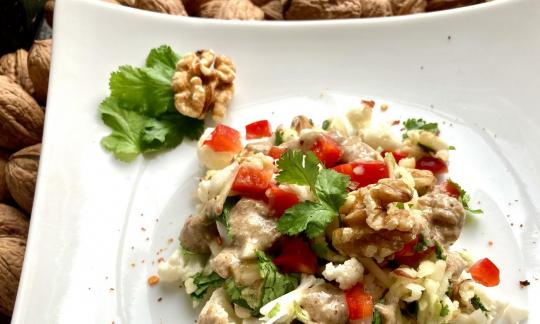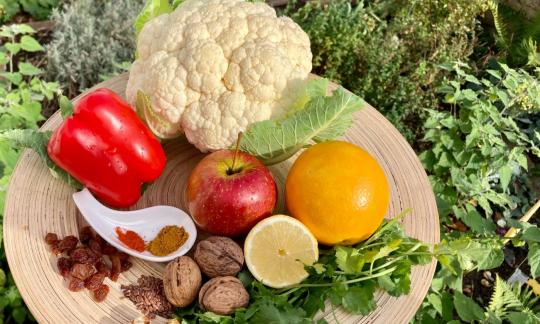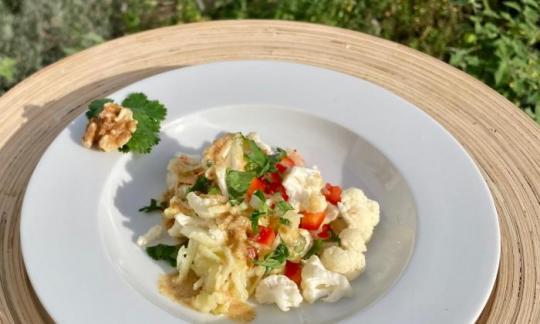Raw cauliflower salad with curry, apple, walnut and coriande
raw-vegan
Ingredients (for servings, )
| For the salad base | |
|---|---|
| 7 ½ oz | Cauliflower, raw (organic?) |
| 1 small | Sweet peppers, red, raw (organic?) (3.9 oz) |
| 1 | Apple, raw, with peel (5.3 oz) |
| For the dressing | |
| 2 tbsp | Lemon juice (raw?, organic?) (0.51 oz) |
| 2 tbsp | Orange juice (raw?, organic?) (0.52 oz) |
| ½ oz | Raisins, raw? (organic?) |
| 1 ½ tbsp, ground | Linseed, raw, organic? (golden linseed, flax) (0.37 oz) |
| ½ oz | Walnuts (tree nuts), raw (organic?) |
| 1 dash | Table salt (table salt, raw?, organic?) (0.01 oz) |
| ¼ tsp | Chili powder (raw?, organic?) (0.02 oz) |
| ½ tsp | Curry powder (organic?, raw?) (0.04 oz) |
| ⅔ oz | Walnuts (tree nuts), raw (organic?) |
| topping | |
| ⅔ oz | Coriander leaves, raw |
Equipment
- coffee grinder, electric or hand-held blender / immersion blender or shredder
- grater
- citrus juicer (lemon squeezer)
Type of preparation
- chop or grind
- food preparation without heating
- squeeze
- season to taste
- grate (shred)
Preparation
Preparing the ingredients
Squeeze the lemon and orange and soak the raisins in it.
Wash the cauliflower and divide it into very small florets. Finely chop any finer stalks and use them. Wash the pepper and dice finely. Wash the apple and grate it coarsely with the peel. Put everything in a bowl.We used about half a cauliflower and a medium-sized apple for a portion for 4 people.
For the dressing
Grind the linseed and walnuts in a coffee grinder. Add salt, chili and curry powder. Remove the raisins from the lemon and orange juice and mash them finely with a fork to form a coarse puree. Mix everything together, add to the vegetable salad and mix well.First, grind the walnuts a little in a small coffee grinder. Because of the fat content of nuts and seeds, clean the machine thoroughly afterwards. Alternatively, you can use a hand blender to chop the raisins and nuts. To do this, after grinding the linseed, put all the ingredients for the dressing in a blender and puree using a hand blender.
topping
Roughly chop the walnuts. Wash the coriander and chop roughly.Arranging and Serving
Season the cauliflower salad with salt and chili powder and serve with coriander and walnuts as a topping.
|
Nutritional Information per person
Convert per 100g
|
2000 kcal | |
|---|---|---|
| Energy | 129 kcal | 6.5% |
| Fat/Lipids | 7.2 g | 10.3% |
| Saturated Fats | 0.74 g | 3.7% |
| Carbohydrates (inc.dietary fiber) | 16 g | 5.8% |
| Sugars | 9.1 g | 10.1% |
| Fiber | 4.4 g | 17.5% |
| Protein/Albumin | 3.6 g | 7.1% |
| Cooking Salt (Na:65.5 mg) | 166 mg | 6.9% |
| Essential micronutrients with the highest proportions | per person | 2000 kcal | |
|---|---|---|---|
| Vit | Vitamin C (ascorbic acid) | 69 mg | 86.0% |
| Fat | Alpha-Linolenic acid; ALA; 18:3 omega-3 | 1.4 g | 71.0% |
| Vit | Vitamin K | 27 µg | 36.0% |
| Fat | Linoleic acid; LA; 18:2 omega-6 | 3.5 g | 35.0% |
| Vit | Folate, as the active form of folic acid (née vitamin B9 and | 62 µg | 31.0% |
| Min | Manganese, Mn | 0.55 mg | 28.0% |
| Min | Copper, Cu | 0.24 mg | 24.0% |
| Elem | Potassium, K | 395 mg | 20.0% |
| Vit | Vitamin B6 (pyridoxine) | 0.28 mg | 20.0% |
| Prot | Tryptophan (Trp, W) | 0.04 g | 16.0% |
Detailed Nutritional Information per Person for this Recipe
The majority of the nutritional information comes from the USDA (US Department of Agriculture). This means that the information for natural products is often incomplete or only given within broader categories, whereas in most cases products made from these have more complete information displayed.
If we take flaxseed, for example, the important essential amino acid ALA (omega-3) is only included in an overarching category whereas for flaxseed oil ALA is listed specifically. In time, we will be able to change this, but it will require a lot of work. An “i” appears behind ingredients that have been adjusted and an explanation appears when you hover over this symbol.
For Erb Muesli, the original calculations resulted in 48 % of the daily requirement of ALA — but with the correction, we see that the muesli actually covers >100 % of the necessary recommendation for the omega-3 fatty acid ALA. Our goal is to eventually be able to compare the nutritional value of our recipes with those that are used in conventional western lifestyles.
| Essential fatty acids | per person | 2000 kcal |
|---|---|---|
| Alpha-Linolenic acid; ALA; 18:3 omega-3 | 1.4 g | 71.0% |
| Linoleic acid; LA; 18:2 omega-6 | 3.5 g | 35.0% |
| Essential amino acids | per person | 2000 kcal |
|---|---|---|
| Tryptophan (Trp, W) | 0.04 g | 16.0% |
| Threonine (Thr, T) | 0.13 g | 14.0% |
| Lysine (Lys, K) | 0.20 g | 11.0% |
| Valine (Val, V) | 0.18 g | 11.0% |
| Isoleucine (Ile, I) | 0.13 g | 10.0% |
| Leucine (Leu, L) | 0.22 g | 9.0% |
| Phenylalanine (Phe, F) | 0.14 g | 9.0% |
| Methionine (Met, M) | 0.04 g | 5.0% |
| Vitamins | per person | 2000 kcal |
|---|---|---|
| Vitamin C (ascorbic acid) | 69 mg | 86.0% |
| Vitamin K | 27 µg | 36.0% |
| Folate, as the active form of folic acid (née vitamin B9 and | 62 µg | 31.0% |
| Vitamin B6 (pyridoxine) | 0.28 mg | 20.0% |
| Biotin (ex vitamin B7, H) | 7.4 µg | 15.0% |
| Thiamine (vitamin B1) | 0.13 mg | 12.0% |
| Pantothenic acid (vitamin B5) | 0.60 mg | 10.0% |
| Vitamin A, as RAE | 65 µg | 8.0% |
| Riboflavin (vitamin B2) | 0.10 mg | 7.0% |
| Vitamin E, as a-TEs | 0.89 mg | 7.0% |
| Niacin (née vitamin B3) | 0.90 mg | 6.0% |
| Essential macroelements (macronutrients) | per person | 2000 kcal |
|---|---|---|
| Potassium, K | 395 mg | 20.0% |
| Phosphorus, P | 91 mg | 13.0% |
| Magnesium, Mg | 42 mg | 11.0% |
| Sodium, Na | 65 mg | 8.0% |
| Calcium, Ca | 39 mg | 5.0% |
| Essential trace elements (micronutrients) | per person | 2000 kcal |
|---|---|---|
| Manganese, Mn | 0.55 mg | 28.0% |
| Copper, Cu | 0.24 mg | 24.0% |
| Iron, Fe | 1.0 mg | 7.0% |
| Zinc, Zn | 0.67 mg | 7.0% |
| Selenium, Se | 1.7 µg | 3.0% |
| Iod, I (Jod, J) | 1.3 µg | 1.0% |
| Fluorine, F | 11 µg | < 0.1% |
This oil-free raw vegan cauliflower salad with curry, apple, walnut and coriander tastes aromatic and fruity and is very low in calories.
Nutrient profile: According to GDA guidelines, one portion of this dish covers 85% of the average daily requirement of vitamin C and 70% of that of omega-3 fatty acids. The ratio of omega-6 to omega-3 fatty acids is 3:1, well below the recommended maximum ratio of 5:1. In addition, the dish is very low in calories, with just 128 kcal per portion. You can find out more at: Vegans often eat unhealthily. Avoidable nutritional errors.
Cauliflower: Cauliflower is one of the most easily digestible brassicas. In addition to white, cauliflower is also available in orange, purple and green. It has a high vitamin C content and is also rich in B vitamins and K vitamins.
Apple: The raw apple ( Malus domestica) is rich in health-promoting secondary plant substances, which are found not only in the flesh but also in the core and in up to five times higher concentrations in the peel. It consists of 85% water. Among other vitamins, it contains vitamin C, although the content of this depends greatly on the type of apple.
Walnuts: In Central Europe, the common walnut ( Juglans regia) is particularly important. Of all known nuts, the walnut has the highest proportion of alpha-linolenic acid (ALA). It also has health benefits thanks to its high levels of tocopherols ( forms of vitamin E) and many trace elements.
Flaxseed: Flaxseed is the seed of the flax plant (common flax, Linum usitatissimum). Flaxseed has a slightly nutty taste and a fat content of around 40%. With around 50% of the polyunsaturated omega-3 fatty acid ALA, this has the highest concentration of omega-3 fatty acids of all known vegetable oils. Those who eat a lot of industrial food should increase the amount of flaxseed in their diet and correct any nutritional errors in this regard.
Coriander: Coriander leaves, sometimes also known as Chinese parsley, have a refreshing, lime-like taste for some people. Others, however, have a strong aversion to its taste and smell. Studies have shown that such aversion can be traced back to genetic differences. Coriander leaves spoil quickly and should therefore be used as fresh as possible.








